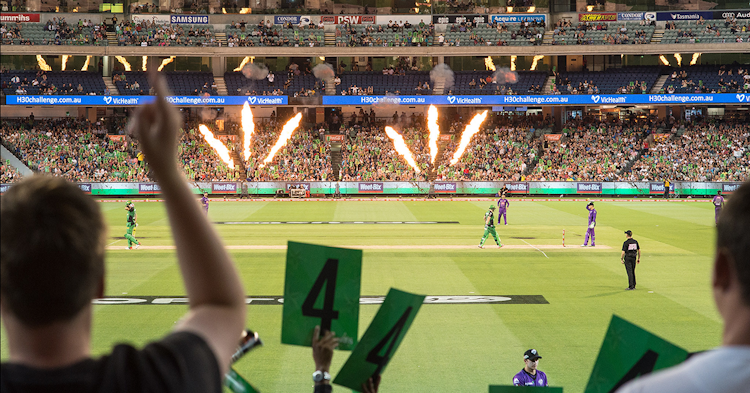Melbourne Stars: The Secret To Their Consistent Success
Last updated: Dec 18, 2020, 7:26AM | Published: Dec 18, 2020, 2:05AM
This image is a derivative of T20 Big Bash League by werdan (CC BY-SA 2.0)
The early BBL|10 title favouritism is with the Melbourne Stars, who’ve come a long way in the past few seasons after finishing rock bottom under Stephen Fleming in 2017-18.
The Stars have been runners-up the past two seasons, having finished minor premiers in BBL|09, while they’ve started this campaign unbeaten with two wins and a washout from their first three games.
When it comes to the Stars, we’re naturally inclined to think about the big-name batsmen such as Glenn Maxwell and Marcus Stoinis as driving their success. After all, Stoinis was the Player of the Tournament last season, on the back of a league-high 707 runs at an average of 54.23, while ‘The Big Show’ Maxwell was 10th overall for scoring with 398 runs.
But close analysis of recent data suggests their recent revival has actually come from a different source. Let's take a look.
RELATED: Why 'Death Bowling' Is So Critical In T20 Cricket
Run Rates For vs Against
Net Run Rate (NRR) is typically used in cricket to order ladders if sides can’t be split on points. It’s a universal method, yet it doesn’t generally gain much analysis from commentators.
NRR can at times be inflated or deflated by small target run chases, leading to a pursuit without the normal risk. But generally NRR is quite accurate for a side’s ability to score quickly and not leak runs at a high rate as well.
To clarify, it’s measured via the well-known concept of the run rate (runs scored per over). NRR simply divides a side’s run rate when batting (amount of runs scored divided by overs faced) compared to their opposition’s run rate. It’s a measure of the ability to score but also strangle.
Earlier in the week we delved into recent history since the Stars claimed the wooden spoon in BBL|07, finishing last with a 2-8 record and a league worst NRR of -0.926.
That season, the Stars were actually in the top four for Run Rate For (RRF), but they were dead last for Run Rate Against (RAA). Long story short, they were leaking runs.
Twelve months later, that story totally changed, improving their RRA from 8.89 to 7.69, to finish among the top-three sides in this measure. Their RRF actually went down, yet they went from last to finishing fourth and making the Grand Final.
They continued that in BBL|09, finishing top, with the league best RRA at 7.51. The perception may have been they scored quick runs but they actually finished outside the top-four sides for RRF.
So far in BBL|10, albeit with a small sample size, those trends have continued with the Stars second for RRA, behind only the Sixers whose numbers are inflated after bowling out the Renegades for 60 in 10.4 overs (NRR calculates this as 20 overs as they were all out).
The point of this data is to clarify that the Stars’ recent rise has come from their economical bowling and strangling of opposition, rather than brute run scoring.
Who’s Doing The Job?
Across recent seasons, there’s one constant – Adam Zampa - who largely goes under the radar, yet produces consistently low economy rates. Already this season, albeit across only two games, he’s conceding just 4.25 runs per over.
He had plenty of help in BBL|09 where the Stars remarkably had seven bowlers who’d bowled 10 overs or more throughout the season registering an economy rate of 8 or less. They only had five achieve this in BBL|08, although three were under 7 per over, including Zampa.
Check out all of Stats Insider's Player DNA visualisations
While in BBL|07, when they finished last, they only had four concede less than 8 per over, with none less than 7.
Sandeep had the best economy rate for the Stars in BBL|08 and was tight again in BBL|09 so his absence will be worth monitoring. Zahir Khan, who is yet to play, looms as his direct replacement.
On paper, the Stars appear soft in the bowling department, with Sandeep and Dale Steyn having left, while last season's sensation Haris Rauf will only play towards the end. With that said, there’s more to their bowling than meets the eye.
Final Thoughts
It’s starting to emerge in world cricket that the most enduring, successful T20 teams generally combine the ability to both to post big scores, along with consistently suppressing opposition runs.
Yes, big hitters like Maxwell, Stoinis, Nicholas Pooran, Ben Dunk and Andre Fletcher play crucial roles in getting their teams in positions to win, yet it's often the unheralded impact of economical bowling which seals wins, and ultimately helps lift trophies.
Did you enjoy this article? Join our free mailing list to get the best content delivered straight to your inbox, or join the conversation by leaving a comment below or on the Stats Insider Twitter or Facebook page.



